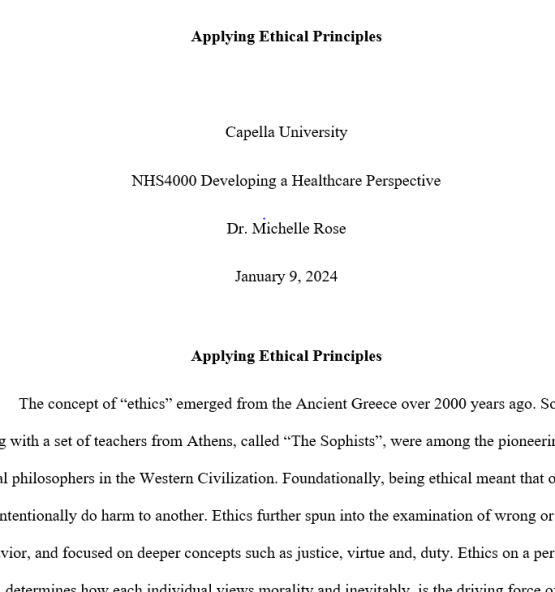


Applying Ethical Principles
Capella University
NHS4000 Developing a Healthcare Perspective
Dr. Michelle Rose
January 9, 2024
Availability:In Stock
Effective communication allows healthcare professionals to demonstrate professionalism and commitment to delivering patient-centered care. The director of clinical services showed excellent skills such as active listening and collaboration to address the ethical dilemma highlighted in the case. Straight engaged the operating room supervisor and the nurse while intently listening to their responses on events that transpired during the surgery. Objective conversations create a conducive atmosphere for members of the care team to explain the situation (Howick et al., 2018). The director’s efforts to engage different professionals to show awareness about shared governance, when making decisions on safety and quality of care.
A hypothetical question asked by the director also helped strengthen the communication process. The option allowed the director to consider the options available, including getting the patient back to the surgical room. However, the director was aware of the existence of a general surgeon who was physically and mentally weak. The failure to seek feedback from Cutrite raises concerns about the director’s commitment to finding a sustainable solution to the situation.
In this case, the director failed to demonstrate commitment to breaking hierarchical barriers when addressing ethical dilemmas. Kim and Cruz (2022) encouraged healthcare leaders to embrace leadership traits and qualities that enable them to eliminate the status quo and power distances created by senior members. The case highlights the need for leaders to listen intently to the staff and demonstrate rational decision-making in challenging scenarios. The situation also reminds leaders to overcome hierarchical barriers that limit them from engaging senior employees responsible for negligence and errors.
The error in the surgical room portrays one of the serious concerns for healthcare professionals responsible for handling complex procedures. Addressing such errors requires the care team to understand the principles of moral awareness, moral judgment, and ethical behavior (Martins et al., 2021). The director demonstrated moral awareness by acknowledging the error. The step reinforced decision to seek clarification on events that led to the team leaving an object in a patient’s belly.
The director also exercised moral judgment by making significant steps toward investigating the issue and its implications for the patient. Recognizing the relevance of moral awareness and judgment allowed the director to stick to the right ethical behavior (Martins et al., 2021). Straight understood the issue and consequences, which allowed him to agree with the conclusions of the chief of surgery. Thus, it was appropriate to avoid getting the patient back to the operating room after considering all options and their implications on the client’s health and well-being.
Beneficence, non-maleficence, justice, and autonomy principles allow healthcare professionals to demonstrate high levels of professionalism. Autonomy encourages the healthcare team to acknowledge a patient’s right to self-determination on a preferred treatment pathway. In the Missing Needle Protector, the facility violated the autonomy principle by failing to inform the patient about the object left in her belly and seeking an opinion on the preferred action. Beneficence is the other ethical principle that enables the care team to respond to a patient’s best interests (Varkey, 2021). The director made efforts toward understanding the causes of the error and its implications on the patient’s health and well-being.
However, allowing a physically and mentally weak surgeon to operate raised questions about the organization’s commitment to fulfilling the beneficence principle. Similarly, the care team ignored the non-maleficence principle by failing to use a comprehensive checklist and having incompetent staff as part of the operating team. Varkey et al. (2021) reminded organizations to eliminate risks that expose a patient to physical, emotional, and psychological distress. As such, healthcare leaders should make evidence-based and patient-centered decisions that help enhance the quality and safety of patient care. Complete adherence to ethical principles means eliminating lapses that undermine the patient’s well-being within and outside the facility.
Reviews
There are no reviews yet.